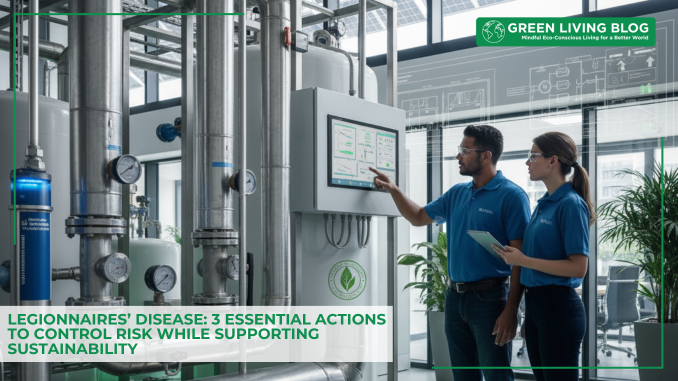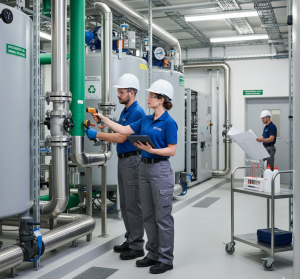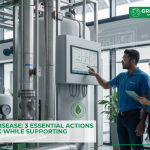
In today’s business environment, organisations are under increasing pressure to balance their legal health and safety obligations with a growing commitment to environmental sustainability.
growing commitment to environmental sustainability.
For those managing water systems, this balance can feel especially challenging. Maintaining water safety, particularly in preventing Legionnaires’ disease,can sometimes seem at odds with efforts to reduce carbon emissions and conserve resources.
However, the good news is that safety and sustainability do not have to be mutually exclusive. With the right planning and expertise, it is entirely possible to manage Legionella risks while remaining environmentally responsible.
Below are three essential steps that every organisation should take to control the risk of Legionella bacteria, without compromising sustainability goals.
1. Begin with a Legionella Risk Assessment: A Legal and Strategic Foundation
The first and most critical step in managing Legionella risk is to carry out a professional Legionella risk assessment. This is not simply a best-practice recommendation; it is a legal requirement under UK health and safety legislation, specifically the Health and Safety at Work Act 1974 and associated guidance such as ACOP L8 and HSG274.
A comprehensive Legionella risk assessment, conducted by a qualified and competent professional, will identify potential hazards within your water systems. These risks are often introduced during the design, installation, or modification of plumbing systems, and may not be immediately apparent without expert evaluation.
Failure to identify and mitigate these risks early can result in a need for costly remedial work, frequent maintenance visits, or, in severe cases, chemical treatment to eliminate bacterial contamination such as biofilms.
Each of these interventions can carry a significant environmental cost:
- Additional engineer site visits increase vehicle emissions and fuel consumption.
- The use of disinfectant chemicals involves manufacturing, transport, and careful disposal.
- Short-term fixes can lead to increased water usage and waste.
By proactively assessing and addressing risks at the earliest possible stage, ideally during system design or installation, organisations can reduce their long-term environmental footprint, lower operating costs, and remain compliant with legal requirements.
2. Use Intelligent Technology That Supports Both Safety and Sustainability
Modern water heating and circulation systems such as ground source heat pumps and air source heat pumps offer excellent energy efficiency and are increasingly popular among environmentally conscious businesses. However, these systems can pose challenges for Legionella control, as they often operate at lower temperatures that fall within the risk range for bacterial growth.
Fortunately, many modern systems are now equipped with intelligent Legionella control features. These built-in functions allow systems to operate at energy-efficient temperatures during normal use but periodically increase the water temperature above 60°C to disinfect the system and eliminate harmful bacteria.
This automated approach provides a practical balance between safety and sustainability:
- It ensures lower daily energy consumption during routine operation.
- It supports compliance with HSG274 guidance by enabling periodic thermal disinfection cycles.
- It reduces the need for chemical dosing and manual interventions.
- It can extend the life of the system by preventing biofilm buildup through controlled temperature cycling.
By selecting and installing systems with this type of smart functionality, businesses can reduce their environmental impact while maintaining full compliance with Legionella safety regulations.
3. Design Water Systems That Eliminate Risks and Reduce Maintenance
One of the most effective and sustainable ways to manage Legionella risk is to design water systems that are inherently safer and require less ongoing maintenance. Good system design reduces the conditions under which Legionella bacteria can thrive, such as stagnation, lukewarm temperatures, and dead legs in pipework.
For example, strategically placing lower-use outlets upstream of high-use outlets encourages regular water flow throughout the system, reducing the likelihood of stagnation.
This kind of design consideration can significantly reduce the need for:
- Manual flushing procedures.
- Routine maintenance visits to underused outlets.
- Unnecessary water waste caused by preventative flushing.
By designing out risk from the outset, organisations can reduce operational costs, limit resource consumption, and improve system longevity. This design-led approach not only helps protect people from illness but also aligns with corporate sustainability objectives by saving time, water, and energy.
Smart Planning Leads to Safe and Sustainable Water Management 
The most effective way to manage both Legionella risk and environmental responsibility is to consider water safety at the planning and design stages of any project. Whether you are constructing new premises, upgrading existing systems, or adopting more energy-efficient technologies, early engagement with a Legionella consultant is essential.
By involving a qualified specialist from the beginning, businesses can:
- Prevent potential issues before they escalate.
- Avoid the need for extensive remedial works later on.
- Minimise the use of chemicals, reduce water waste, and lower carbon emissions from maintenance travel.
- Design systems that are safe, compliant, and efficient for the long term.
Before you begin your next building or refurbishment project, ask yourself this critical question:
“What can we do right now to manage Legionella risk sustainably?”
If you are unsure of the answer, it is time to speak with a Legionella expert. Consulting with a specialist early ensures that your water systems are both safe for users and aligned with your organisation’s environmental goals.
Protecting people and the planet should not be a trade-off. With smart planning, it can be your standard practice.
![]()
Author Profile
- Passionate content creator, contributor, freelance writer and content marketing allrounder.
Latest entries
 Green Home GuidesDecember 10, 2025How Windows and Doors Can Cut Your Energy Bills and Help the Planet
Green Home GuidesDecember 10, 2025How Windows and Doors Can Cut Your Energy Bills and Help the Planet EnvironmentNovember 18, 2025What Are Ecological Surveys? Definition, Purpose, and Process
EnvironmentNovember 18, 2025What Are Ecological Surveys? Definition, Purpose, and Process BusinessOctober 23, 2025Legionnaires’ Disease: 3 Essential Actions to Control Risk While Supporting Sustainability
BusinessOctober 23, 2025Legionnaires’ Disease: 3 Essential Actions to Control Risk While Supporting Sustainability EnvironmentJuly 21, 2025Why Fat Balls Are Good For Your Local Bird Population
EnvironmentJuly 21, 2025Why Fat Balls Are Good For Your Local Bird Population







Leave a Reply
You must be logged in to post a comment.